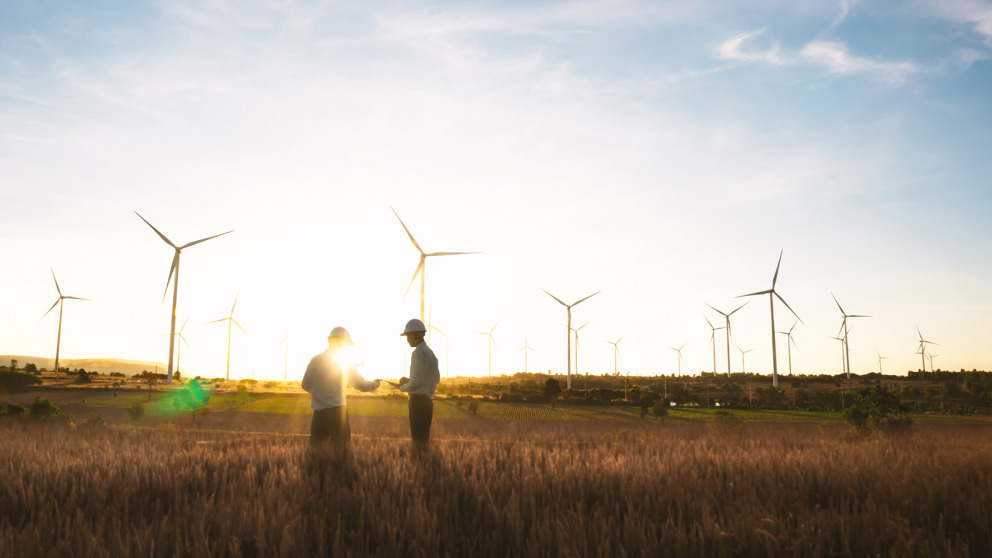Ending Subsidies Slows the Growth of Wind and Solar Power
12.10.2021

By Marc Melliger (IASS) and Emile Chappin (TU Delft)
Falling prices for renewables such as wind and solar are prompting policymakers at the national and European levels to consider phasing out support mechanisms. In a new scientific study, we show that discontinuing these instruments could have negative effects on the growth of these renewables. We arrived at this conclusion with the aid of a model in which we have integrated empirical investor preferences for the first time.
Prices for new wind and solar power plants are plummeting
The cost of building new wind and solar power plants is falling worldwide. Just a few years ago, however, electricity from renewable sources was considerably more expensive than coal-fired electricity, for example. Investments in renewables relied substantially on the support of state subsidies. Support schemes like feed-in tariffs, facilitated in Germany through the Renewable Energy Sources Act (EEG), helped these immature technologies to achieve their breakthrough.
Subsidies for wind and solar power still play an important role in 2021, although EU directives now require that auctions be held to allocate them. Moreover, some bidders no longer bother to apply for subsidies [1]. The emergence of this practice suggests that auctions could be discontinued, and the ongoing expansion of renewables left entirely to market forces. From a neo-liberal perspective, this would be a desirable outcome. However, there are drawbacks to the phase-out of support.
Although the need for direct payments has indeed diminished, the current support regime offers other advantages, in particular in the area of risk mitigation (see also our views on the German EEG). In light of this, we suspected (and have shown) that EU countries would miss the emission reduction targets established in their National Energy and Climate Plans (NECPs) without support. Missing these targets would not be good news for the climate.
Support for renewables still necessary
Our new study [2] contributes to the current debate on support mechanisms. In it, we explore the effects of ending auctions for wind and solar power within the coming decade. We used an agent-based model (EMLab Generation 2) to simulate possible changes in electricity prices and renewables growth after such a policy change.
For the two case studies of Germany and the Netherlands, we were able to show that discontinuing auctions would slow the growth of wind power by up to 60% and the growth of solar power by as much as 35%. That would not be good news! This would particularly affect onshore wind and photovoltaic projects in Germany as well as offshore wind projects in both countries. Our model suggests that these results are due to reductions in the expected returns (of the simulated investors) during periods of high renewable electricity generation.
We also discovered interactions between the two countries. These would play a role, for example, [3] if only Germany changed its policy. As the electricity grids in these two countries are connected, discontinuing support mechanisms would affect (wholesale) electricity prices in the (smaller) Netherlands.
What this suggests is that auctions are still necessary to support mature renewables. We also concluded that EU countries will need to coordinate among themselves in order to better respond to unexpected and counterintuitive price changes. This could improve the planning and design of future support schemes.
Model extends toolbox to include socio-economic aspects
Our results are based on scenarios [4] that we simulated using EMLab Generation 2. Agent-based models of this type enable researchers to model the actions of individual actors in order to understand the behaviour and response of systems [5]. In this case, our model simulates the investment decisions of electricity producers in an interconnected electricity market. In previous versions of the model, such decisions were based on purely economic criteria. However, studies have shown that investors also have non-economic preferences, e.g. for certain technologies or countries.
To address this deficit, we have integrated empirical preferences from a previous IASS study into EMLab Generation. Our findings show that this significantly affects investment algorithms and outcomes. Future studies should also take such preferences into account. This can improve the empirical basis of modelling results and expand the modelling toolbox by adding socio-economic aspects (as previously discussed within the IASS research group Energy Transition Dynamics).
The blog article of Emile Chappin elaborates on the modelling aspects of this study.
Funding
This research was funded by the European Research Council under the TRIPOD project (Contract No. 715132).
[1] In other words, a bid is submitted for a subsidy of €0.00. Such actors participate in the auctions not to gain subsidies but to obtain access to electricity grids.
[2] The article will be accessible to the public until 25 November 2021. A preprint version will be available on the IASS Preprint Server from 8 October 2023.
[3] As our research shows, such effects also occur when both countries change their policies.
[4] In the scenarios, countries discontinue their auctions for wind and solar power individually or together.
[5] As agents have only incomplete information (about the behaviour of others, for example), agent-based models can assess the consequences of individual policies more comprehensively and realistically. In contrast, optimization models deliver results that are only applicable to perfectly functioning markets, i.e. when all actors are fully informed. However, this is rarely the case.